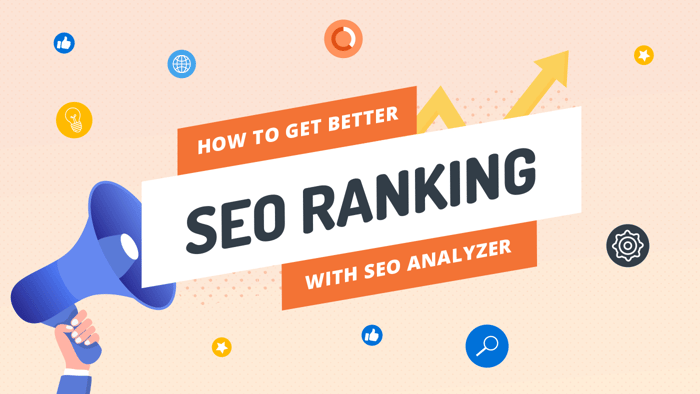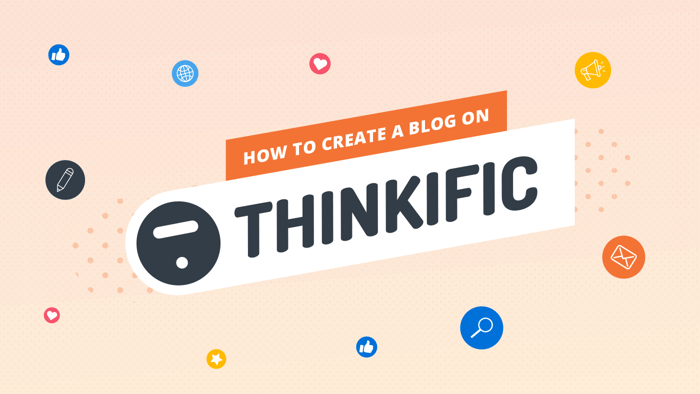Thinkific and Udemy are both online platforms that enable instructors to host and sell their courses. However, don’t let that trick you into thinking that Thinkific and Udemy are identical. In this Thinkific vs. Udemy comparison, we’ll show you that it’s not exactly an “apples to apples” comparison.
| A quick comparison: | ||
| Thinkific | Udemy | |
| Price |
|
|
| Help and support |
|
|
| Key features | Everything you need to:
|
|
Table of Contents
What Is Thinkific and Who Is It For?
Thinkific is a platform where instructors can create, host, market, and sell their courses on their own course site. Its focus is on instructors, meaning it’s meant to give them all the necessary tools, including sales and marketing tools, to build, maintain, and grow their online education business.
With Thinkific, you create your own brand, and it’s perfectly suitable for long-term business development in the online learning niche.

What Is Udemy and Who Is It For?
Udemy is also a course-creation and course-hosting platform. It does the majority of the marketing for you, and your course is placed on its site. In essence, there isn’t an option for you to manage the marketing side of your business or develop your own brand.
In contrast to Thinkific, Udemy is student-centered rather than instructor-centered. There’s not much easy-to-find guidance for instructors, and there isn’t anything along the lines of a complete list of available features for instructors to use. You have to dig and search to find more information on the options available for instructors at Udemy.
It seems that the focus of the platform is much more on enabling enthusiastic learners to find tons of courses easily rather than helping people who are serious about starting an online education business. It perfectly fits the bill for avid learners who wish to upskill without paying a lot of money.

Udemy is, in a way, the Etsy of online learning businesses. It’s like a big course market where everybody has their own stand for selling their courses. So, while you don’t have your own site to sell your courses from, neither do your Udemy competitors.
Since you don’t have to develop a website and manage the marketing, it’s best suited (although not exclusively) for complete beginners. You will be able to test out how popular your courses are without having to worry about also building your own brand. Udemy is so popular that you essentially gain exposure through their online presence and marketing efforts.
Price
How Much Does Thinkific Cost?
When it comes to pricing plans, Thinkific offers several possibilities:
1. Free
- Price: Completely free.
- Best suited for: Test-driving Thinkific’s essential features.
- Highlights: Unlimited students, analytics, and multiple types of course content.
- Downside: You can only create a limited number of courses.
2. Basic
- Price: $49/month (monthly subscription) or $39/month (annual subscription).
- Best suited for: The early stages of online education business development.
- Highlights: Unlimited courses, an affiliate program, and a custom domain.
- Downside: Thinkific branding all over your course site.
3. Start
- Price: $99/month (monthly) or $79/month (annually).
- Best suited for: Well-established instructors with a relatively large community of students.
- Highlights: Certificates of completion, memberships, and the ability to remove Thinkific branding.
- Downside: No significant downsides.
4. Grow
- Price: $199/month (monthly) or $149/month (annually)
- Best suited for: Well-established businesses going through significant growth.
- Highlights: API access and the ability to remove Thinkific branding. You also get priority phone and email support.
- Downside: Costs can add up after a while.
5. Expand
- Price: contact customer service for specifics
- Best suited for: rapidly growing businesses.
- Highlights: All the features of the Grow plan, only in larger quantities.
- Downside: Could be more than you need and therefore expensive.
6. Thinkific Plus
- Price: A custom plan for large enterprises.
- Best suited for: Large enterprises.
- Highlights: Email white labeling, unlimited products, and unlimited administrators.
- Downside: Could be expensive if your business isn’t bringing in enough revenue.
All Thinkific plans are easily switchable, and there’s a 30-day money-back guarantee.
How Much Does Udemy Cost?
There are no upfront costs with Udemy, which means that it doesn’t charge anything for you to have your courses uploaded on the platform. It also doesn’t charge anything for creating courses with the tools it provides. In that sense, it’s free.
So, how does Udemy make a profit? From commissions. Signing up for teaching on Udemy is like starting a partnership with the company. It takes a pretty big cut from your earnings – 50%, to be exact.
So, let’s say someone is browsing Udemy’s site or clicks on a promotional offer and finds your course and decides to buy it. In this case, Udemy will take half of your sales price.
If you decide to promote your course through your own marketing efforts, you have an opportunity to earn more. In this case, buyers make a purchase using either your coupon or a course referral link, and Udemy takes only 3% of your sale (or 4% if you reside in Japan).
There’s one more situation where you let Udemy promote you via its affiliate program or paid advertising. In this case, you’ll get only 25% from the sale.
On top of this, Udemy is frequently offering discounts – pretty big discounts at that. You also have to consider that there’s a price cap policy, and you’re unable to charge more than $199.99 for a course. This does actually hinder your ability to make quick profits. It’s not just the fact that the company takes big cuts from your earnings, but also the fact that the possibilities for profit for course creators are reduced.
Help and Support
Customer support is one of the most important aspects of any type of business. No matter how good the tools a platform offers, it also has to provide good support – or risk losing customers. I don’t think it’s an exaggeration to say that this kind of business stands or falls on how good its customer service is.
Let’s see what Thinkific and Udemy offer in terms of help and support.
Thinkific
Thinkific provides support through various channels and in different ways:
- A contact page
- An introductory demo video
- Social media
- An FAQ section
- A help center
- A Facebook page for the Thinkific community
- A training center
- Phone (during business days from 9 to 5 PST)
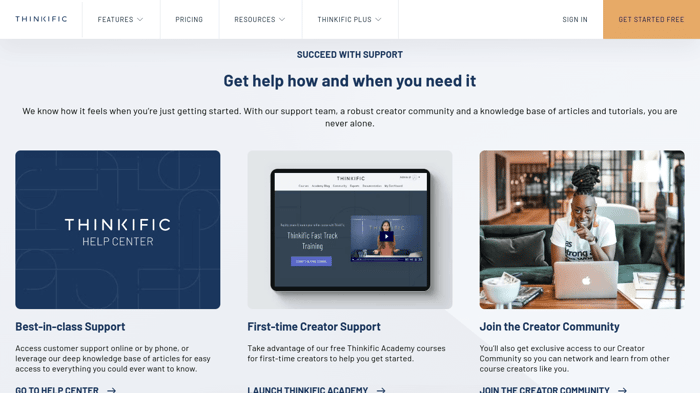
The biggest advantage of the Thinkific help and support system is its phone support center. However, the biggest downside is the absence of live chat, which is very popular nowadays.
The Thinkific support staff is considered to be friendly, helpful, and professional. Thinkific claims that 98% of the emails it receives are answered within one day and 50% of these emails receive a reply within one hour.
I wasn’t able to confirm these claims, and based on more than a few reviewers, the email support seems to be a bit slower than what’s reported by the company itself.
Udemy
In terms of support, Udemy includes:
- A support page
- A help center page
- A teaching center
- An FAQs section
- A contact page where you can send an email to the customer support team
The FAQ section has many articles as well as how-to guides on various topics. All this content is segmented into six different categories:
- Payments
- Selling and promotion
- Quality standards
- Course building
- Course management
- Trust and safety
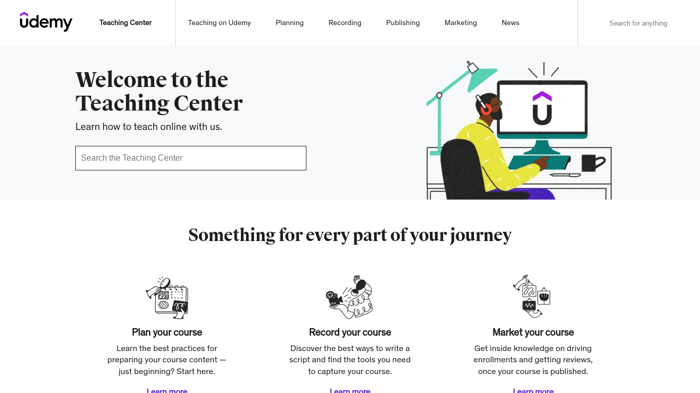
To me, the biggest problem with Udemy is that the platform is set up with students in mind, not the teacher. This means getting further information and troubleshooting help when you’re getting set up is a bit difficult.
Unlike Thinkific and other similar platforms, with Udemy you’ll have to search hard to find answers to your questions. They do provide a chat service, which could be its saving grace, except it’s more like a forum than live chat. Phone support is definitely not an available option.
Features, Pros, and Cons
We can’t successfully conclude this Thinkific vs. Udemy comparison without exploring at least part of the features the two platforms offer. So, let’s have a look at the key aspects of these two online learning platforms.
Thinkific
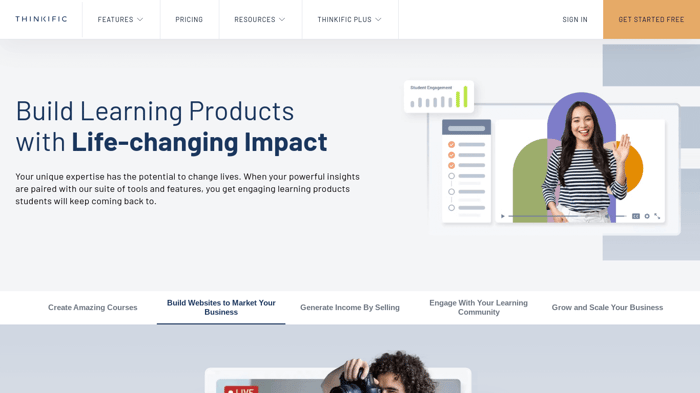
A complete list of Thinkific features wouldn’t fit in a couple of pages, let alone in the short span of this article. In other words, Thinkific simply has too many features to list.
All features are sorted into seven categories:
- Course creation
- Sales and marketing
- Design customization
- Student experience
- Teaching
- Site administration
- Security support
This is only a fraction of what Thinkific provides in terms of features, tools, and perks:
- Course content of any type, like video, audio, PDF, and more
- Content creation tools
- Course reviews and discussions
- Quizzes and surveys
- Unlimited students and unlimited courses
- Downloadable course content
- Free, paid, and time-limited courses
- Order tracking
- SEO
- Various payment methods and multiple currencies
- Customizable pages
- Multiple language support
- Student progress tracking and monitoring
- Welcome and course completion emails
- Reports and analytics
- SSL certificate
- Reliable and secure hosting
- Drip content
- Affiliate system
- Custom domain
- Email integrations
- Bundles and memberships
- Advanced customization
The best thing about Thinkific is that you have almost full control over anything related to your course site. You decide what courses to bundle, how to develop a marketing campaign, and design your course structure the way you want. Thinkific just provides you with what you need and lets you build your education empire.
With Thinkific, you completely own your courses, the students’ data, and analytics. Also, you have all the freedom in the world to price your courses for how much you think they’re worth.
Additionally, the drag-and-drop site builder gives you the ability to create different types of pages and customize them in line with your brand.
However, it’s not all roses with Thinkific. For starters, it doesn’t offer blogging functionality. This needn’t be an issue, though, since you can integrate a third-party app instead. DropInBlog, easily one of the best – if not the best – blogging software on the market is easily integrated with Thinkific. DropInBlog enables you to create a stunning-looking blog on your Thinkific site in no time.
In addition to this, Thinkific doesn’t have a marketplace, while the checkout, thank you, and upsell pages are pretty basic, and there isn’t a built-in community forum. Some customers also report the site builder to be unsatisfactory. Nevertheless, when you put the advantages and disadvantages on the scale, the advantages presented by Thinkific far outweigh the disadvantages.
Udemy
The biggest advantage of Udemy is its massive popularity and the vast community of users. These are some of the numbers found on its site:

Those are pretty big numbers – I’m sure you’ll agree. What this means for you is that Udemy gives you a lot of exposure and, with it, many potential students to sell your courses or instructional videos to.
However, since it’s built the way it is, there’s also a lot of competition coming from instructors just like you on the same platform. Currently, there are about 213,000 courses on Udemy. If you’re offering a course on a popular topic, you could be in for some fierce competition.
When it comes to features and customization, Udemy doesn’t perform that well. Let’s take a look at some of the more notable features:
- Course promotion through coupons and referral links
- PayPal or Payoneer as payment methods
- Bulk file uploader
- Practice tests and course assignments
- Traffic, conversion, and course engagement stats
- Captions and caption editing tool
- Auto-generated subtitles
- Promotional emails
- Ability to add a teaching assistant
- Unlimited courses
Although this is not a complete list, the number of available features and tools Udemy provides pales in comparison to Thinkific. Those features that are available are considered pretty basic.
Design customization options are at the bare minimum. There are no personalized automated emails, multiple pricing options, upsells, bundles, groups, advanced marketing integrations, or course bundles. No white labeling, theme picker, site builder, custom domain, drip content, course and layout customization, and no instant access to your funds (you need to wait for 2-3 months to get your money, mainly because of the 30-day refund policy).
This means very limited control over pricing, student interaction, and branding – essentially, very limited control over your online learning business.
However, if you simply want to publish courses and sit back and relax, you may find it easier to use. If you can manage to get consistently good student reviews on one or more courses, your rating and potential customer base will grow.
Because Udemy is more of a course listing and hosting service than a course building platform, in a way, that gives you flexibility. You can create courses however you like, without the use of any course builder, and then just upload them to Udemy at no cost. This is probably the perfect option for beginners with limited capital and limited investment capacity.
FAQs
Does Udemy take a huge cut on my course sales?
Unfortunately, yes. Udemy essentially does all the hard work hosting and promoting your courses, so they do take a commission from your course sales. Typically the commission is 50%, which can be considered a huge cut.
Can I attach a custom domain to Udemy?
No, with Udemy, you don’t create your own website and cannot attach a custom domain. Udemy simply gives you a place to upload and sell your courses. This removes some hassle of web development, management, and marketing, but it also has other downsides.
How do Thinkific and Udemy compare against Teachable?
Thinkific and Teachable are very similar platforms, both allowing you the features and functionality to build a website and develop your own online education business. On the other hand, Udemy is a platform to place your courses easily, but your ability to build your brand is severely restricted.
Final Thoughts
Overall, Thinkific is a much better online education platform for instructors. Although it’s not without its faults, Thinkific offers much more in terms of quality, tools, design, marketing, control, brand-building, and opportunities for profit.
With Udemy, there are so many limitations. Although you save time and hassle not having to build a website and market your education business, you’re forever tied to Udemy. Even your students are not your clients – they’re Udemy’s clients.
Although I’ve seen some reputable and high-quality instructors selling their courses on Udemy, based on my research and reviewers’ experiences, I don’t think Udemy is a good option for building a serious education-centered business. However, if that’s not your intention and you don’t want to invest too much time and energy into your side hustle – Udemy is great, and Thinkific would be too much.
In this Thinkific vs. Udemy showdown, Thinkific definitely has the edge, but in certain cases, Udemy could be just what you’re looking for.


